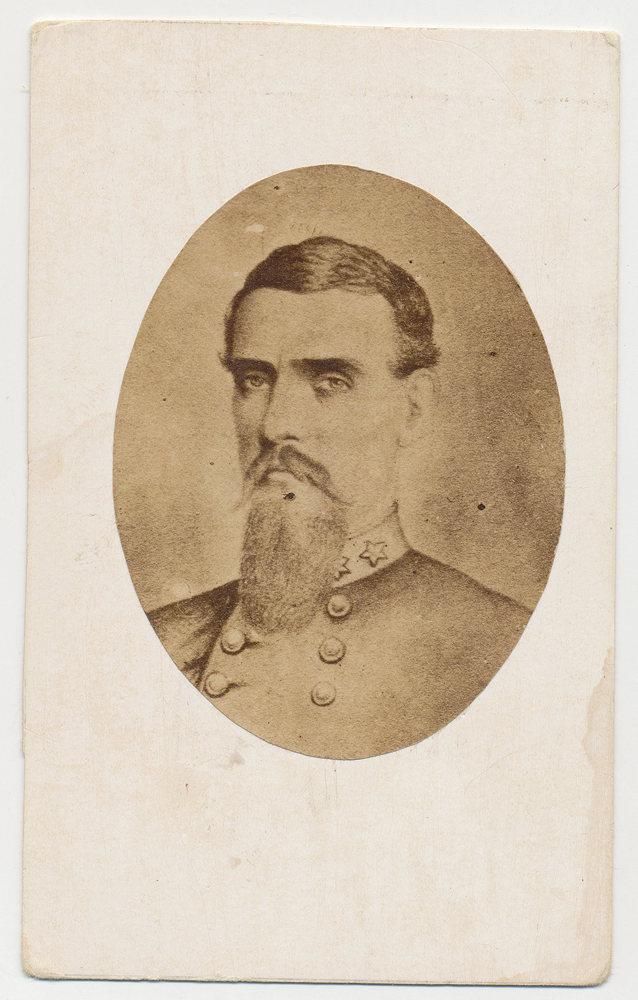site search
online catalog
WARTIME LITHOGRAPH OF CONFEDERATE GENERAL ROGER PRYOR

Hover to zoom


$300.00
Quantity Available: 1
Item Code: 1138-1767
Shipping: Determined by Method & Location of buyer
To Order:
Call 717-334-0347,
Fax 717-334-5016, or E-mail
CDV is an oval chest-up view of Pryor in Confederate uniform.
Clarity and contrast are good as are the paper and mount.
Reverse is blank but for a modern misidentification at top of “MATTHEW PRYOR” and collector information in modern pencil at bottom.
From the collection of the late William A. Turner.
Roger Atkinson Pryor was born near Petersburg, Va., July 19, 1828, and was graduated at Hampden-Sidney college in 1845, and at the university of Virginia in 1848.
Subsequently he prepared for the legal profession, and was admitted to the bar, but relinquished the practice on account of delicate health, and entered journalism. After an association with the Washington Union, he became editor of the Richmond Enquirer in 1853, and rapidly attained prominence.
In 1855, at the age of twenty-seven years, he was sent to Greece by President Pierce, as special commissioner for the adjustment of certain difficulties with that government. On his return he established a political journal at Richmond, called The South, in which he presented with great vigor the most radical opposition to encroachments upon the local rights and industrial methods of the South.
He was elected to Congress in 1859, to fill a vacancy, and was re-elected in 1860. While in Congress his aggressiveness and passionate oratory gave him national prominence, and led to several duels. He took a prominent part in the proceedings of the Charleston Democratic Convention in 1860, and after the presidential election ardently advocated the formation of the Southern Confederacy and the union with it of Virginia.
Repairing to Charleston, S. C., he became a member of the volunteer staff of General Beauregard, and with his comrade, A. R. Chisholm, accompanied Aide-de-camps James Chestnut and Stephen D. Lee in the visit to Fort Sumter April 12th, notifying Major Anderson that fire would be opened on the fort.
Thence they went by boat to Fort Johnson, where Capt. George S. James was ordered to open the fire. James, who was a great admirer of Pryor, offered the honor to him, as General Lee relates, but he replied, with much the same emotion as had characterized Anderson's receipt of the notice of bombardment, "I could not fire the first gun of the war. "
From their boat midway between Johnson and Sumter, he witnessed the opening of the bombardment. After the flag on Sumter was shot down, he was sent with Lee to offer assistance in subduing the fire in the fort, and discovered that Colonel Wigfall had made arrangements for surrender.
Soon afterward he was assigned as colonel to the command of the Third Virginia regiment, stationed at Portsmouth and vicinity, and later in the year was elected a member of the First Confederate Congress, in which he served with prominence as a member of the military committee.
Continuing in military command, he moved his regiment to Yorktown in March, 1862, and engaged in battle at Yorktown and Williamsburg, after which he was promoted brigadier general.
In this rank he participated in the battle of Seven Pines, and was particularly distinguished, his men fighting bravely and with heavy loss, in the victories won at Gaines' Mill and Frayser's Farm.
With Longstreet's corps he took part in the second battle of Manassas, and shared the distinction won by Anderson's Corps at Harper's Ferry and Sharpsburg. In November General Lee requested Pryor to return to Richmond and organize a brigade to operate south of the James River.
He rendered valuable services in that field until his resignation, August 26, 1863. In 1864 he was captured by the United States troops and for a time confined at Fort Lafayette.
Upon the close of hostilities, he urged a policy of quiet acquiescence in the results of the war, but did not long remain in the South, removing to New York City, and embarking in the practice of law, in which he attained great distinction. The degree of LL. D. was conferred upon him by Hampden-Sidney college.
General Pryor died in New York City on March 14, 1919 and is buried in Princeton Cemetery, Princeton, New Jersey. [ad] [ph:L]
~~~~~~~~~~~~~~~~~~~~~~~~~~~~~~~~~~~
THIS ITEM, AS WITH ALL OTHER ITEMS AVAILABLE ON OUR WEB SITE,
MAY BE PURCHASED THROUGH OUR LAYAWAY PROGRAM.
CLICK HERE FOR OUR POLICIES AND TERMS.
THANK YOU!
Inquire About WARTIME LITHOGRAPH OF CONFEDERATE GENERAL ROGER PRYOR
Most Popular
Historical Firearms Stolen From The National Civil War Museum In Harrisburg, Pa »
Theft From Gravesite Of Gen. John Reynolds »
Selection Of Unframed Prints By Don Troiani »
Fine Condition Brass Infantry Bugle Insignia »
Large English Bowie Knife With Sheath 1870’S – 1880’S »
Imported (Clauberg) Us Model 1860 Light Cavalry Officer's Saber »
featured item
IDENTIFIED ISSUE RED BLANKET OF THEODORE P. BOWKER 13th MASSACHUSETTS - DIED OF WOUNDS AT ANTIETAM!
This is a rare, early-war, identified Massachusetts issue red blanket carried by a soldier in the 13th Massachusetts who was wounded at Antietam on Sept. 17, 1862, and died of those wounds at a U.S. hospital at Rappahannock Station on November 12.… (490-7138). Learn More »


